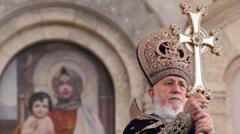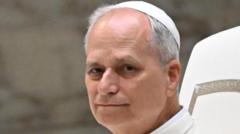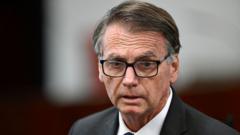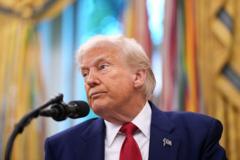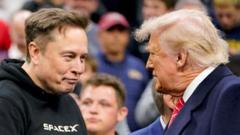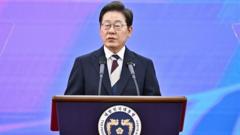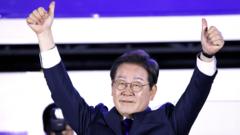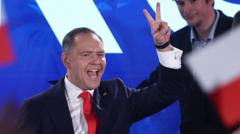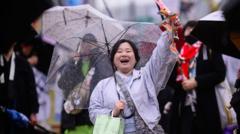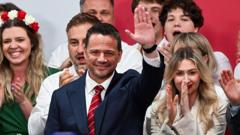The cardinals gathered in Vatican City are engaged in a prolonged conclave, now experiencing uncertainty as black smoke signals a lack of consensus on a new pontiff. As they prepare for more rounds of voting, discussions reveal a backdrop of ideological divisions within the church.
Conclave Continues as Black Smoke Signals Ongoing Deadlock in Papal Votes

Conclave Continues as Black Smoke Signals Ongoing Deadlock in Papal Votes
The conclave remains undecided after a second day of voting, with black smoke emerging from the Sistine Chapel, indicating no pope has been chosen yet.
The conclave to elect the successor to Pope Francis is underway, but anticipation turned to disappointment this Thursday morning as black smoke rose from the chimney of the Sistine Chapel, signaling no decision had been reached after votes on the first day. The crowd gathered in St. Peter's Square expressed its displeasure, having hoped for swifter action since Pope Francis’ death last month has led to this momentous event, the first in over a decade.
The significant number of 133 voting cardinals are participating, amid a backdrop of increasingly complex dynamics within the church. Experts are suggesting that the new, diverse faces within the conclave could lead to a more fragmented decision-making process than previous elections. Many cardinals, appointed by Francis, are unaccustomed to the inner workings of such a pivotal selection, with diverse perspectives surfacing on issues like inclusion and church doctrine.
The voting procedures are regimented. Each secret ballot, conducted four times daily, determines whether the cardinals are able to hone in on a viable candidate for the papacy. If a candidate does not achieve a two-thirds majority, black smoke signals continues voting. Should they agree on a new pope, white smoke will signify the successful outcome.
The unpredictability of conclave durations adds another layer of uncertainty; while recent elections concluded within two days, the current dynamics could lead to a lengthier deliberation period. Historical contexts are fluid, with memorable conclaves lasting anywhere from just hours to nearly three years, reflecting the weight of tradition and politics intertwined in these sacred proceedings.
Conservative factions within the church express concerns over the direction of the next papacy, with phrases like “unity” evoking potential rollbacks of Francis' progressive initiatives. Experts agree that the ideological divide may lengthen discussions as cardinals balance competing priorities in hopes of finding a candidate that resonates within both liberal and conservative circles.
As voting resumes in the afternoon, hope remains among onlookers in St. Peter's Square for the uplifting moment white smoke will deliver the choice of a new pope, but the need for patience prevails, as the selection process continues its ancient and secretive path. As the world watches, the conclave’s ongoing drama unfolds, deeply intertwining with the broader trajectory of the Roman Catholic Church’s future.
The significant number of 133 voting cardinals are participating, amid a backdrop of increasingly complex dynamics within the church. Experts are suggesting that the new, diverse faces within the conclave could lead to a more fragmented decision-making process than previous elections. Many cardinals, appointed by Francis, are unaccustomed to the inner workings of such a pivotal selection, with diverse perspectives surfacing on issues like inclusion and church doctrine.
The voting procedures are regimented. Each secret ballot, conducted four times daily, determines whether the cardinals are able to hone in on a viable candidate for the papacy. If a candidate does not achieve a two-thirds majority, black smoke signals continues voting. Should they agree on a new pope, white smoke will signify the successful outcome.
The unpredictability of conclave durations adds another layer of uncertainty; while recent elections concluded within two days, the current dynamics could lead to a lengthier deliberation period. Historical contexts are fluid, with memorable conclaves lasting anywhere from just hours to nearly three years, reflecting the weight of tradition and politics intertwined in these sacred proceedings.
Conservative factions within the church express concerns over the direction of the next papacy, with phrases like “unity” evoking potential rollbacks of Francis' progressive initiatives. Experts agree that the ideological divide may lengthen discussions as cardinals balance competing priorities in hopes of finding a candidate that resonates within both liberal and conservative circles.
As voting resumes in the afternoon, hope remains among onlookers in St. Peter's Square for the uplifting moment white smoke will deliver the choice of a new pope, but the need for patience prevails, as the selection process continues its ancient and secretive path. As the world watches, the conclave’s ongoing drama unfolds, deeply intertwining with the broader trajectory of the Roman Catholic Church’s future.

